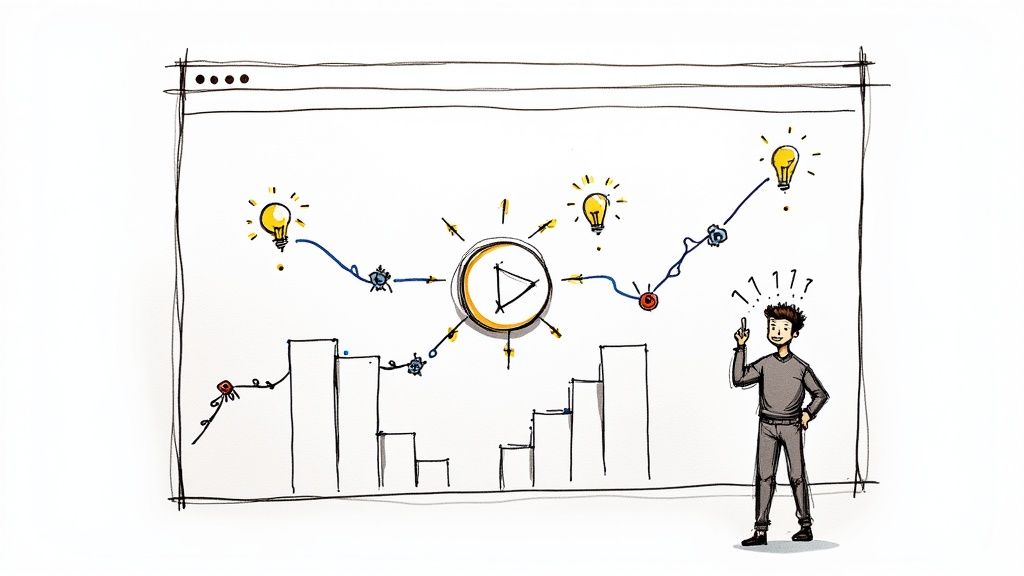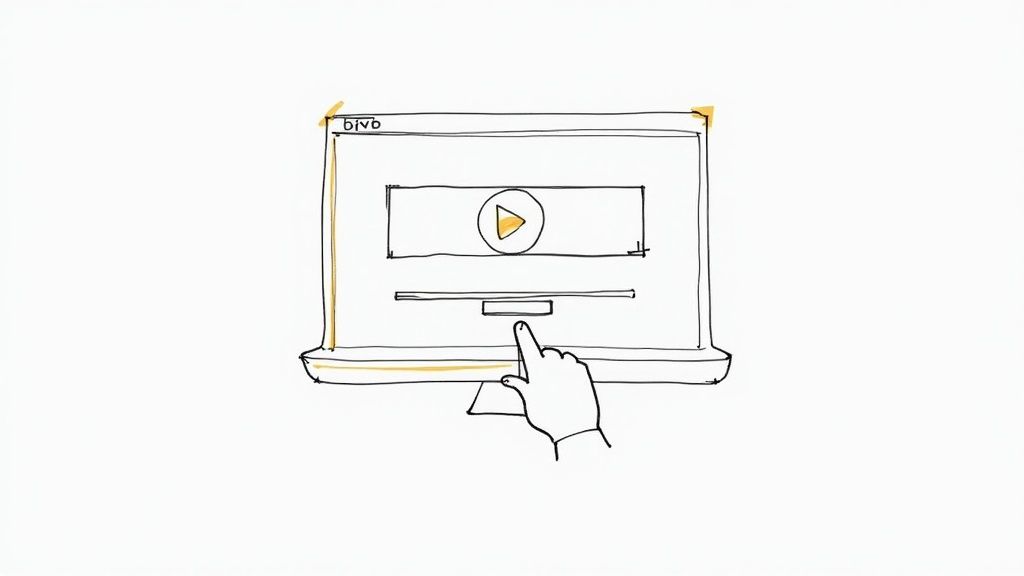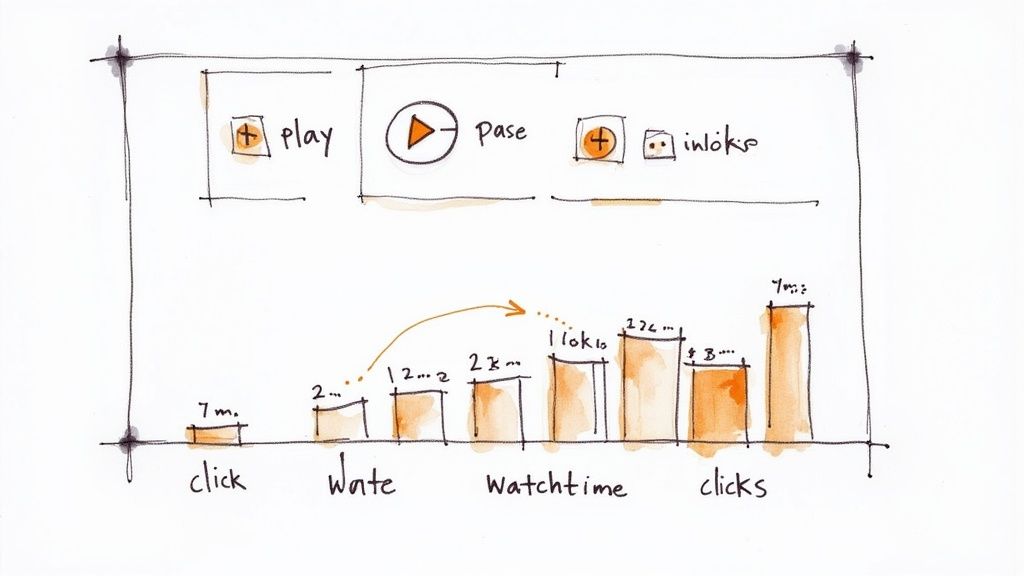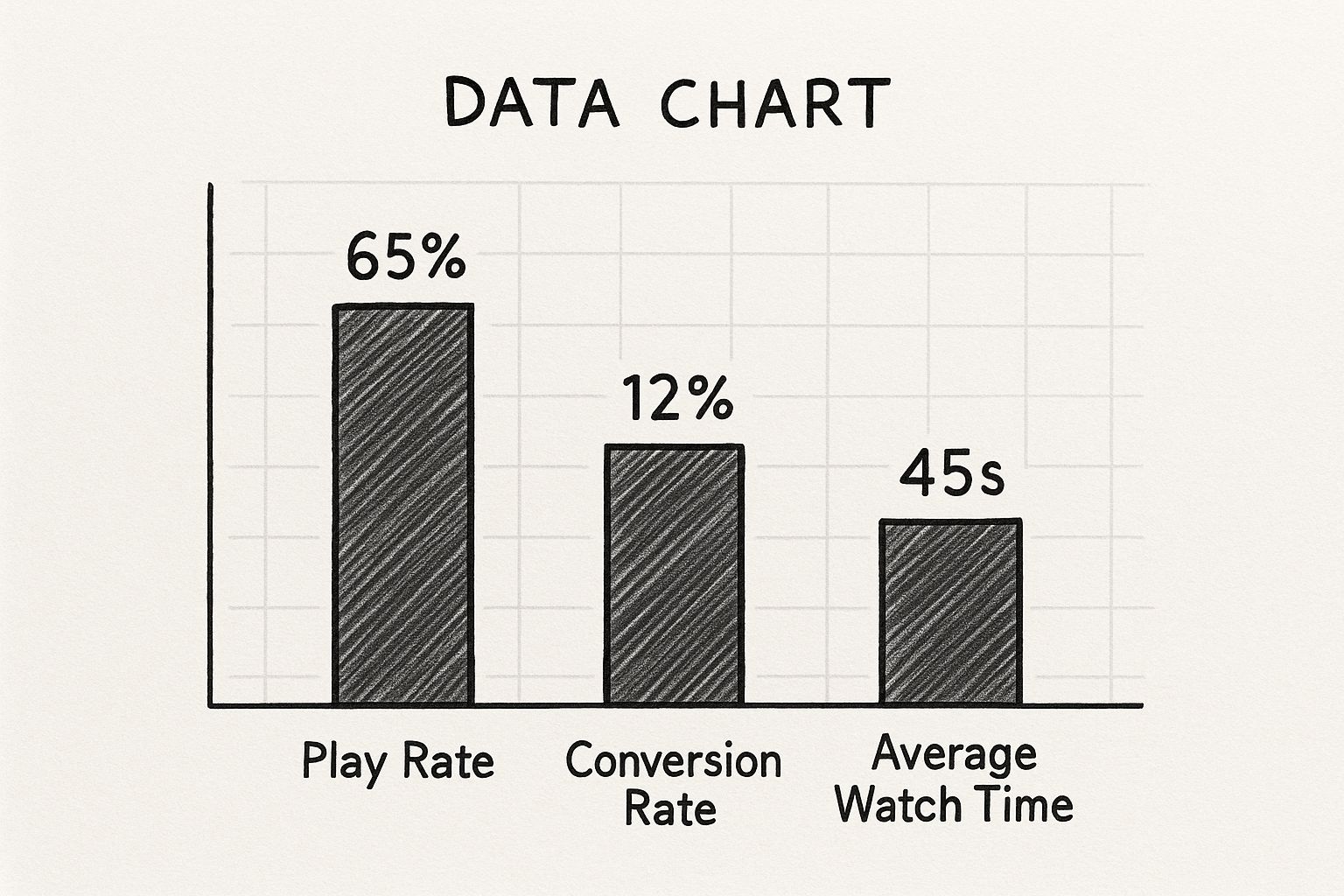
Boost Engagement with Videos on Landing Pages
Let's be honest, most corporate training is a snoozefest. We've all been there—staring at a dense training manual or scrolling through a text-heavy landing page, trying to keep our eyes open. This old-school approach just doesn't work anymore. The result? Poor engagement, weak knowledge retention, and a team that’s not on the same page about critical information.
A standard training manual is like a silent, flat textbook. It throws information at you but does little to inspire genuine learning.
Why Static Training Fails and Video Succeeds
In contrast, a landing page built around video feels more like a dynamic, guided workshop. It shifts the experience from passive reading to active learning. This is a huge deal because today's employees expect content that's both useful and engaging, just like the media they consume in their own time. When you put a wall of text in front of them, they're going to skim, skip, or simply tune out.
The Engagement Crisis in Corporate Learning
The real problem with static content is that it’s a one-way street. It talks at the learner, never with them. This passive consumption leads directly to what learning pros call the "forgetting curve," where a huge chunk of what you "learned" vanishes almost immediately.
Here’s a quick rundown of why those old methods just don't cut it anymore:
- No Visuals: Try explaining a complex piece of software or a multi-step process with just text and a few screenshots. It's a nightmare. Video lets you show, not just tell.
- Information Overload: Huge documents are overwhelming. It's tough for employees to pull out the key takeaways when they’re buried in fluff.
- One-Size-Fits-None: Static pages can't adjust to different learning speeds. Some people get left in the dust while others are bored to tears.
The challenge isn't just delivering information. It's making sure that information actually sticks and gets put into practice. Static content almost always fails to build that bridge.
From Passive Viewing to Active Learning
This is where videos on landing pages completely change the game for corporate training. By embedding dynamic, interactive content, you’re not just sharing information; you’re creating a real educational environment. Tools like Mindstamp are built for exactly this, turning passive video watching into an engaging learning experience.
Instead of just sitting through a presentation, employees can actually participate in their own learning.
For example, you can drop questions right into the video to check for understanding on the fly. This simple trick keeps viewers engaged and confirms they're actually absorbing the material. You can even create branching scenarios that present learners with real-world challenges, letting them make decisions and see the outcomes in a safe space. This kind of active involvement is what makes training memorable, effective, and ultimately, successful.
The Real Impact of Video in Corporate Learning

The true power of using videos on landing pages for corporate learning goes way beyond just catching someone's eye. It taps directly into the science of how we actually learn and remember things. A good video doesn't just throw facts at you; it crafts an experience that makes tough subjects easier to grasp and way more memorable than any slide deck ever could.
Think about it—video hits multiple senses at once. It pulls together visuals, audio, and text, which means it works for all kinds of learning styles. Whether your employee needs to see a process in action or hear a clear explanation to really get it, video delivers.
Simplifying Complexity Through Visuals
One of the biggest headaches in corporate training is trying to break down complicated topics, like a new software workflow or dense compliance rules. Text-heavy manuals can quickly turn into a confusing jumble of jargon and steps, leading to nothing but frustration and errors.
Video cuts right through that noise with one simple trick: showing, not just telling. Imagine trying to explain how to use a new CRM with a PDF versus a quick screencast. The video gives you context, shows you exactly where to click, and moves at a pace you can follow. That kind of direct visual guidance just wipes out any guesswork and helps people get up to speed faster.
On top of that, weaving a story into a training video creates an emotional hook. A short narrative about a real-world workplace problem and how to solve it is infinitely more engaging than a dry list of policies. That connection helps lock the lesson into the learner's memory for good.
Ensuring a Consistent Message for All Teams
With so many teams working remotely or spread across different locations, keeping the training message consistent is a huge challenge. Different trainers might stress different things, and remote folks can easily miss the little details from in-person sessions. This can create knowledge gaps and performance issues across the company.
Videos on landing pages are the perfect fix. They create a single, official source of truth. Every single employee, no matter where they are or when they take the training, gets the exact same information delivered in the exact same way.
This consistency is non-negotiable for critical stuff like compliance, safety protocols, and brand messaging. Video ensures the core message never gets watered down or twisted, creating a unified understanding for everyone.
And the impact is massive. When a polished video is front and center on a landing page, engagement shoots up. In fact, research shows that adding a video can boost conversions by as much as 80% because it grabs attention and makes complex information easy to digest. You can discover more insights about the impact of video on landing page conversion rates.
Humanizing Corporate Communications
Beyond just spitting out information, video has a unique knack for making corporate communications feel more, well, human. Seeing and hearing from company leaders, subject matter experts, and even fellow team members builds a connection that plain text just can't match. This is especially important for remote teams who might feel a bit disconnected from the company culture.
When a training video features real people in real situations, it feels less like a corporate decree and more like a conversation. This approach helps build a stronger sense of community and trust. It shows your team that you're genuinely invested in their development by giving them training that’s clear, relatable, and designed for them. That human element makes the whole learning process a lot more positive and motivating.
Creating Training Videos That Actually Work

Alright, let's get down to brass tacks. Moving from a great idea to a great training video takes a plan. And no, this isn't about renting expensive cameras or hiring a Hollywood crew. It’s about a smart, structured process that puts your learner first—and it all starts long before you even think about hitting the record button.
Think of a solid training video like a well-built bridge. Its sole purpose is to get someone from Point A (not knowing) to Point B (knowing and doing). The pre-production phase is where you draw up the blueprint for that bridge.
Phase 1: Pre-Production and Planning
Before you touch any equipment, you need to define what success even looks like. Ask yourself: What is the one single thing a learner must be able to do after watching this video? Is it navigating new software? Understanding a critical compliance policy?
Once you nail that down, scripting becomes a whole lot easier. A good script isn't just a list of facts; it's a conversation that guides the viewer. Keep your sentences short, use everyday language, and—this is crucial—read it out loud. You'll instantly catch any awkward phrasing.
This is also the time to pick the right format for the job:
- Screencasts: Absolutely perfect for software tutorials. You're showing the exact steps someone needs to take.
- Talking Head: Ideal when you're explaining a concept or sharing thought leadership. That human connection builds a ton of trust.
- Role-Playing Scenarios: The go-to for soft skills training, like sales or customer service. It lets learners see best practices in action.
And since we're often talking about mobile viewing on landing pages, you’ll want to check out a creator's guide to vertical video dimensions to make sure everything looks fantastic on a phone.
Phase 2: Production Essentials
With a solid plan in hand, production is just about execution. You really don't need a massive budget. Modern smartphones shoot incredible video, but there are two things you absolutely cannot skimp on: clear audio and good lighting.
Bad audio is a dealbreaker. An inexpensive lavalier mic will sound infinitely better than your camera's built-in one. Similarly, filming near a window or using a simple ring light is the difference between looking amateurish and looking professional.
Remember, the goal of a training video on a landing page is clarity, not cinematic perfection. The viewer must be able to see and hear the information without distraction.
Phase 3: Post-Production and Interactivity
Now for the magic. The editing process is where you assemble your raw footage into a story that makes sense. You'll cut out mistakes, add text overlays to highlight key points, and make sure the pacing feels right.
But for corporate training, this is where you can really level up. It’s your chance to turn passive viewing into active learning. Interactive video platforms like Mindstamp are built for this, letting you embed interactive elements right into your video. This is how you transform a simple playback into a powerful training tool.
Here are a few ways to add that interactive layer:
- Quizzes and Knowledge Checks: Pop in a few questions at key moments to reinforce what you've taught. It gives immediate feedback to the learner and tells you if the message is landing.
- Branching Scenarios: Present a situation and let the viewer choose their own adventure. Their decision takes them down a different path in the video, showing them the real-world consequences of their actions in a safe space.
- Clickable Hotspots: Make parts of your video clickable. A learner can click on a term or an object to get a quick definition or link out to another resource without ever leaving the player.
By intentionally designing your videos on landing pages with these elements, you’re creating more than just a video. You're building a responsive, engaging, and measurable learning experience that actually sticks.
Optimizing Your Landing Page for Video Training

Dropping a video onto a landing page is a good start, but the real magic happens when you optimize the entire experience around it. Think of your landing page as the stage and your video as the main event. You wouldn't just throw a performer on a bare stage, right? You’d need the right lighting, sound, and backdrop to captivate the audience.
It’s the same idea here. Every element on the page—the headline, the text, the call-to-action (CTA)—needs to work in harmony to support your video's training goal. Without that cohesion, even the most polished training video will fall flat.
Strategic Video Placement and Player Settings
Where you put your video can make or break its effectiveness. For any kind of training, the video needs to be the undeniable hero of the page. Placing it above the fold, where it's visible without any scrolling, is a must. This immediately tells your employees what the page is for and removes any guesswork.
Next up are the player settings, which can either boost or tank learning retention. Let's talk about autoplay. It might seem like a clever way to guarantee views, but for training, it’s often disruptive and totally counterproductive.
Autoplay often backfires in a learning context. It can startle the viewer and create a negative first impression, preventing them from mentally preparing to absorb the information. Allowing the user to consciously click "play" gives them control and signals they are ready to learn.
So, how do you earn that click? With a great thumbnail. It should look professional and give a clear hint of what's inside, maybe with a key frame from the video, a friendly face, or text that spells out the topic. Your thumbnail is the mini-advertisement for the training itself.
A well-planned video placement strategy is key. Depending on where you place the video and what you want the learner to do, your approach will change.
Here's a quick breakdown of how placement and CTA effectiveness can vary for training landing pages:
Video Placement and CTA Strategies
Each strategy has its place, but for most corporate training, keeping the video front and center (above the fold) with a clear, action-oriented CTA is the winning formula.
Choosing the Right Platform for Training
The video player you use is just as important as the video itself. A standard YouTube embed might be fine for your public-facing blog, but it just doesn't cut it for corporate training. You need more control, better security, and way more data.
This is where a professional interactive video platform like Mindstamp changes the game. It’s built from the ground up for learning and development, offering features you simply won't find on a public platform.
Here’s a quick look at why it matters:
- Advanced Analytics: Forget simple view counts. Mindstamp gives you per-user engagement data, quiz results, and even interaction heatmaps. You can see exactly which parts of the training are clicking with employees and where they might be getting stuck.
- Enhanced Security: Training materials are often sensitive. Professional platforms provide solid privacy controls, password protection, and domain restrictions to make sure your content is only seen by the right people.
- Integrated User Tracking: You can connect video data directly to your Learning Management System (LMS) or employee records, building a complete picture of each person's learning journey.
A Checklist for a High-Performing Video Landing Page
Optimizing the whole page gives your video the support system it needs to do its job. It's a proven fact: landing pages with embedded videos can boost conversions by as much as 86% by making content more engaging and trustworthy.
Run through this checklist to make sure you're creating a truly cohesive learning environment:
- Write a Clear, Action-Oriented Headline: The headline needs to spell out the benefit. Instead of "New Software Training," go with something like "Master Our New CRM in Under 15 Minutes."
- Add Concise Descriptive Text: Briefly explain what the viewer will be able to do after watching. Use bullet points to highlight the key takeaways.
- Create a Compelling Call-to-Action (CTA): Your CTA should be specific. Ditch "Submit" for a button that says "Mark as Complete" or "Take the Final Quiz."
- Eliminate Distractions: Get rid of any navigation links, sidebars, or other offers that could pull focus. The page should have one and only one goal: getting the employee to complete the training.
And don't forget to keep improving! To really dial in your video landing page, you should consistently A/B test content strategies to see what works best. By testing different headlines, thumbnails, or CTAs, you can turn a good page into a great one.
How to Measure Real Training Success
Let's be honest. Effective training isn't about how many people clicked "play." True success is about comprehension and application—and that means you have to look far beyond basic view counts. To measure the real return on your video training, you need a way to connect video performance to tangible business outcomes.
Vanity metrics like views and likes might look good in a report, but they tell you absolutely nothing about whether an employee actually learned something. The key is to zero in on actionable data that reveals real engagement and understanding. This is where an interactive video platform changes the game.
Beyond the View Count: KPIs That Matter
Instead of asking, "Did they watch it?" you should be asking, "Did they get it?" To answer that, you need to track Key Performance Indicators (KPIs) that measure genuine interaction. Interactive video platforms like Mindstamp are built specifically to capture this deeper layer of data.
Here are the metrics that truly define training success:
- Viewer Engagement Graphs: These show you, second by second, where your audience's attention holds and where it drops off. A consistent dip at a certain point in your video is a massive red flag, telling you that a concept needs to be explained better.
- Quiz Response Rates: By embedding questions directly into the video, you can measure comprehension in real time. If everyone is getting a specific question wrong, you've instantly pinpointed a knowledge gap that needs to be addressed.
- Completion Paths: For branching scenarios, you can see which decisions learners make. This data is pure gold for compliance or soft-skills training, revealing how well employees can apply policies in simulated situations.
This is a great example of some common metrics you might see.

This chart shows a healthy Play Rate, but the lower Conversion Rate and Average Watch Time suggest a problem. While the video is appealing enough to start, it isn't holding viewer attention long enough to drive the action you want them to take.
A Deeper Look at Video Training Metrics
To really understand what's working, it helps to separate standard video metrics from the more advanced data you get with interactive video. One tells you if they watched; the other tells you how well they learned.
Key Metrics for Training Video Effectiveness
This table makes it clear: interactive metrics give you the specific, actionable insights needed to prove and improve the effectiveness of your training programs.
Connecting Data to Business Outcomes
Once you have this data, you can start making real improvements. See a huge drop-off right before a critical safety procedure is explained? You know that section needs to be more engaging. Are quiz results showing a widespread misunderstanding of a new software feature? Time to create a quick follow-up video to clarify it.
The ultimate goal is to connect video analytics directly to business results. By tracking these deeper metrics, you can draw a straight line from your training initiatives to improvements in key business areas.
This is how you transform training from a cost center into a strategic asset. You can now show concrete evidence that your video training is making a real impact. If you want to dive deeper, we have a complete guide on how to measure training effectiveness that breaks it all down.
Setting Realistic Benchmarks for Success
When you first start measuring, it's important to set realistic goals. It helps to know what "good" looks like. For instance, comprehensive research found that the median landing page conversion rate across all industries is about 6.6%. Understanding benchmarks like this helps you set achievable targets for your own training pages.
Ultimately, your success metrics will be unique to your goals. Here’s how interactive video data can translate into measurable business wins:
- Fewer Support Tickets: If your software training videos actually work, your IT and support teams should see a noticeable drop in those common "how-to" questions.
- Better Compliance Scores: By tracking quiz results and completion of compliance modules, you have an auditable paper trail proving your team understands critical policies.
- Faster Onboarding: High engagement and completion rates for new hire videos lead directly to a faster, more effective onboarding process, getting new team members up to speed and productive much sooner.
By focusing on these meaningful KPIs, you can finally move past the guesswork and start proving the powerful, bottom-line impact of your video training programs.
Seeing Interactive Training Videos in Action
It's one thing to talk about theories, but it’s another thing entirely to see them work in the real world. To make all these ideas really click, let's walk through three different scenarios where companies put videos on landing pages to solve real-deal corporate training problems.
Each example tackles a common business headache with a smart, interactive video solution. We'll look at the problem they faced, the approach they took, and the powerful results they saw.
Case Study 1: Employee Onboarding
The Challenge: A tech firm was growing so fast that its onboarding process was a mess. New hires were getting buried under dense documents and a jumble of presentations. This meant a painfully slow ramp-up period, and remote employees felt totally disconnected from the team.
The Video Solution: The L&D team got to work and built a dedicated onboarding landing page. The star of the show? An interactive video series. It kicked off with a welcome message from the CEO, complete with clickable hotspots introducing key team leads. Other videos walked new hires through company culture, essential tools, and what to expect in their first week. They even sprinkled in short, non-graded quizzes after each module to make sure the key info stuck.
The Measurable Results: The impact was huge. The company saw a 30% reduction in the time it took for new hires to get fully up to speed. Even better, post-onboarding surveys showed a 45% increase in new employees feeling connected to the company culture. It was proof that video could build a genuine human connection right from day one.
Case Study 2: Software Rollout Training
The Challenge: A mid-sized company was trying to roll out new project management software, but adoption was crawling. Employees were confused by the new system and kept defaulting to their old, comfortable methods. This was causing workflow bottlenecks and creating messy data silos.
The Video Solution: Instead of one long, boring tutorial, the training team created a landing page with a whole library of short, feature-specific screencasts. Each video focused on a single task, like "Creating a New Project" or "Assigning a Task." The game-changer? Every video included a "Test Your Knowledge" button that launched a quick quiz, making sure users actually understood the function before they moved on.
By breaking down complex software into bite-sized, task-oriented videos, the company empowered employees to learn at their own pace and find answers to their specific questions on demand.
The Measurable Results: Within just one month, software adoption rates shot up by 70%. The IT department also breathed a sigh of relief, reporting a 60% decrease in support tickets related to the new software. Employees could now solve their own problems using the video landing page.
Case Study 3: Annual Compliance Training
The Challenge: A financial services firm had to get everyone through mandatory annual compliance training. The old way was a dry, 40-page PDF that employees would just skim through. The result? Poor knowledge retention and, you guessed it, failed audits.
The Video Solution: The compliance team decided to try something different. They worked with Mindstamp to build a branching scenario video. This wasn't your typical training video; it dropped employees into realistic workplace situations where they had to make decisions based on company policy. Their choices actually changed the direction of the video, showing them the direct consequences of their actions in a completely safe environment.
The Measurable Results: The numbers don't lie. Quiz scores on the final compliance test improved by an average of 35% compared to the previous year. But the real win? The company passed its next internal audit with zero policy-related infractions, directly tying the interactive training to a massive reduction in organizational risk.
Got Questions? We've Got Answers
Jumping into video for corporate training can feel like a big step, but it's simpler than you might think. Let's tackle a few of the most common questions that come up.
What's the Sweet Spot for Training Video Length?
Stick to 3-7 minutes if you're explaining a single concept. This microlearning style is a lifesaver for busy employees and makes the information much easier to digest and remember.
If you've got a heavier topic to cover, don't try to cram it all into one long video. Instead, break it down into a series of shorter, bite-sized videos and organize them in a playlist. This gives your team a clear learning path they can tackle at their own pace.
Why Not Just Use YouTube?
YouTube is fantastic for cat videos and public-facing content, but for internal training, you need something built for the job. A professional platform like Mindstamp is designed specifically for learning and development.
You get serious advantages like security controls to keep your content private and the power to drop quizzes and questions right into the video timeline. Most importantly, you get detailed, user-specific analytics that show you what your team is actually learning. YouTube can tell you if someone clicked play; a real training platform tells you if they actually understood it.
The biggest win with a dedicated platform isn't just tracking views—it's tracking comprehension. You're not just broadcasting information; you're confirming it was received and understood.
Can I Actually Tell if My Team Understood the Material?
Absolutely. This is where an interactive video platform really shines and proves its worth. A standard video player can only tell you that a video was watched. That’s it.
With a tool like Mindstamp, you can embed questions, polls, and interactive moments directly into the video. The analytics don't just show you who watched and for how long; they show you precisely how each person answered. This gives you concrete proof of comprehension and instantly flags any topics or individuals that might need a little more attention. You're no longer guessing—you know.
Ready to stop wondering if your training is effective and start knowing? With Mindstamp, you can turn passive video lectures into engaging, measurable learning experiences with quizzes, branching paths, and deep analytics. Start building better training videos today.
Get Started Now
Mindstamp is easy to use, incredibly capable, and supported by an amazing team. Join us!



Try Mindstamp Free










